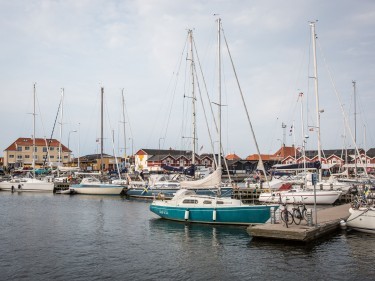With 900 miles of white beaches, an intriguing Viking history and superb Nordic cuisine, North Jutland makes for an alternative European weekend break, says Warren Chrismas
I’m cycling leisurely around the streets of Skagen in the far north of Denmark, and my imagination is clearly running away with me. I’m wishfully eyeing up the properties and picture myself living here.
I’ve only been in the picturesque harbour town for a few hours and I’m a little bit smitten. Really, I don’t know what’s come over me.
I’m intoxicated by the fresh seaside air and I’m dazzled by the bright light which has lured artists for more than a century.
I’m knocked out by the fact that virtually all of the houses are painted in a gorgeous yellow ochre (or ’Skagen yellow’), with rooftops covered in bright red tiles and edged in white.
I assume a law ensures the striking uniformity but, no, our local tour guide assures us that residents are voluntarily sticking to tradition.
It all seems so nice. So civil.
I’m in Denmark to explore North Jutland, the country’s most northerly region, which tempts visitors with 900 miles of white beaches and several natural marvels, not to mention the chance to indulge in some Viking history and Nordic cuisine.
Aalborg, the gateway to the region, is less than two hours from Gatwick, and from spring to autumn, a tour around North Jutland makes for an alternative weekend city break.
Aalborg itself is an industrial city at heart, but has a few points of interest. We take a stroll around the old town, visit the new House of Music on the waterfront and – by chance – catch the Queen of Denmark boarding her official boat.
For lunch, we order a classic herring-on-rye-bread open sandwich at a restaurant in the Utzon Center, an exhibition space designed by locally born Jorn Utzon, best known for designing the Sydney Opera House.
We then head a little out of town to Norresundby to visit Lindholm Hoje, a Viking burial site and former settlement which dates back to the fifth century.
An expert guide is on hand to tell us what the numerous rock formations represent. Background knowledge and some imagination are required here. The exhibits in the museum are more tangible and, to me, a lot more interesting – especially the surprisingly intricate brooches and buckles from the Iron Age.
In the evening we head to Mortens Kro, Aalborg’s best-known restaurant, owned by flamboyant celebrity chef Morten Nielsen. Highlights include a delicious lobster soup and a stunning summer berry desert. The restaurant’s garish decor – which includes some highly risque artwork – isn’t quite so easy to digest.
The following morning we drive 30 or so miles west to breakfast at the popular Svinklov Badehotel, a 90-year-old seaside retreat which offers a homely atmosphere and exceptional food too.
It’s not easy securing a room here, but it’s worth popping by for tea and the speciality layer cake. Some 13,000 slices are sold a year.
Standing on the adjacent beach, with seemingly endless stretches of sand in either direction, I’m tempted to wander off and lose myself for a few hours. But there’s lots to see over two days, and I’m on a tight schedule.
We head north to the edge of Rabjerg Mile, a spectacular migrating dune. Amazingly, the 250-acre stretch of sand is moving north-east at a rate of up to 18 metres a year.
After walking through grassy dunes for a few miles, we find ourselves on top of a huge ridge with fine white sand in every direction. I stop to take it in, and genuinely feel like I’ve been transported to a desert in another continent. It’s quite an experience.
Back in the car, we continue north – in fact, as far north as it’s possible to drive – to the hugely popular tourist destination Grenen. After parking, we catch the ’Sandormen’, a tractor and trailer service which takes us to the end of a two-mile sandbar.
It’s here that, famously, the Skagerrak (part of North Sea) and Kattegat (Baltic Sea) collide in fairly spectacular fashion. Swimming here is prohibited as currents are so strong, but plenty of visitors can be seen paddling and posing for a photo with a ’foot in each sea’.
Finally, it’s on to Skagen, the jewel in the crown of North Jutland. For the record, Danes pronounce it as ’Skane’, with a long ’a’ and a silent ’g’.
After a satisfying lunch at Pakhuset, a charming seafood restaurant packed with colourful wooden mastheads, we head to Skagens Museum to admire paintings from renowned local artists, such as Laurits Tuxen and PS Kroyer. They’re as mesmerising as the town itself.
Although it has the feel of a small harbour or marina, Skagen is in fact the country’s busiest fishing port. It gets incredibly busy in summer, and the population expands from less than 10,000 to 50,000 in July, with hotels and campsites full to bursting. (It’s quieter from mid-August, as kids go back to school earlier than the UK.)
I’m told property prices have gone crazy too. Oh well, moving to Skagen was never very realistic anyway. But for a weekend break, it’s just perfect.
TRAVEL FACTS
:: Warren Chrismas was a guest of the Danish tourist board (www.visitdenmark.co.uk).
:: Stay at the Comwell Hvide Hus (www.comwellaalborg.dk) from 998DKK (£96) per night, or Badehotel Lonstrup (www.villavest.dk) from 898DKK (£86.50) per night.
:: Norwegian (www.norwegian.com/uk) flies to Aalborg from London Gatwick from £29.50 one way.




